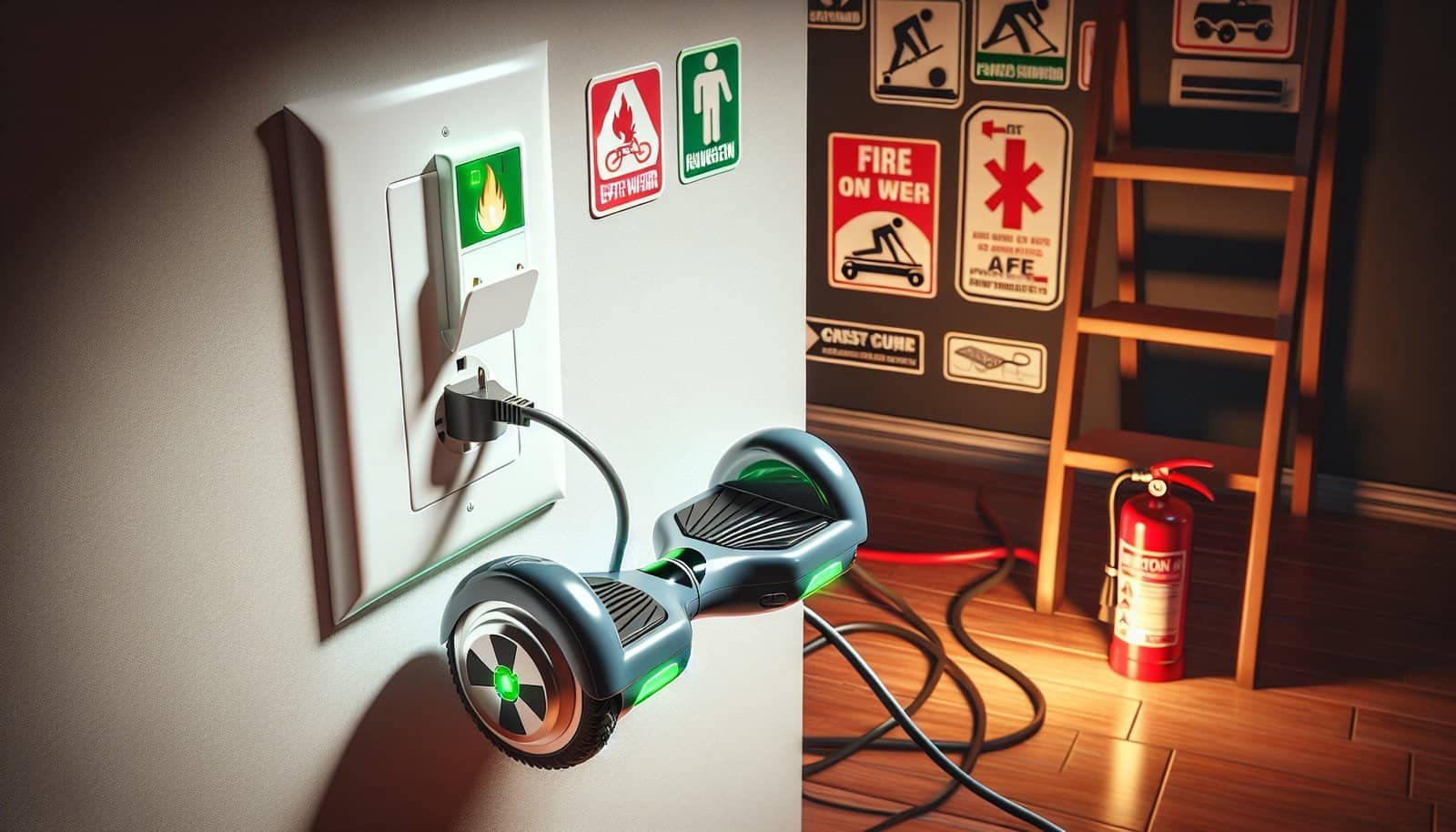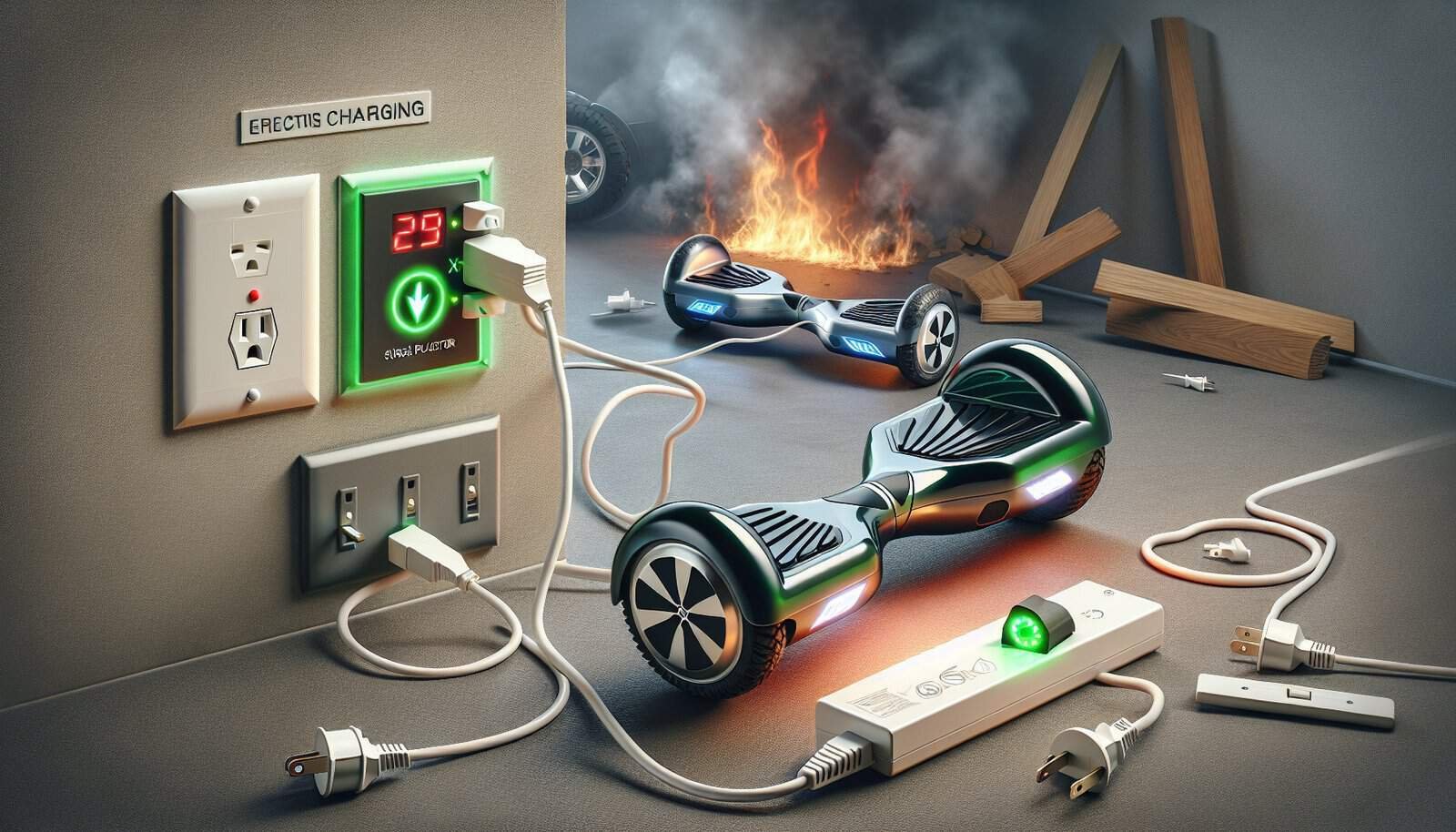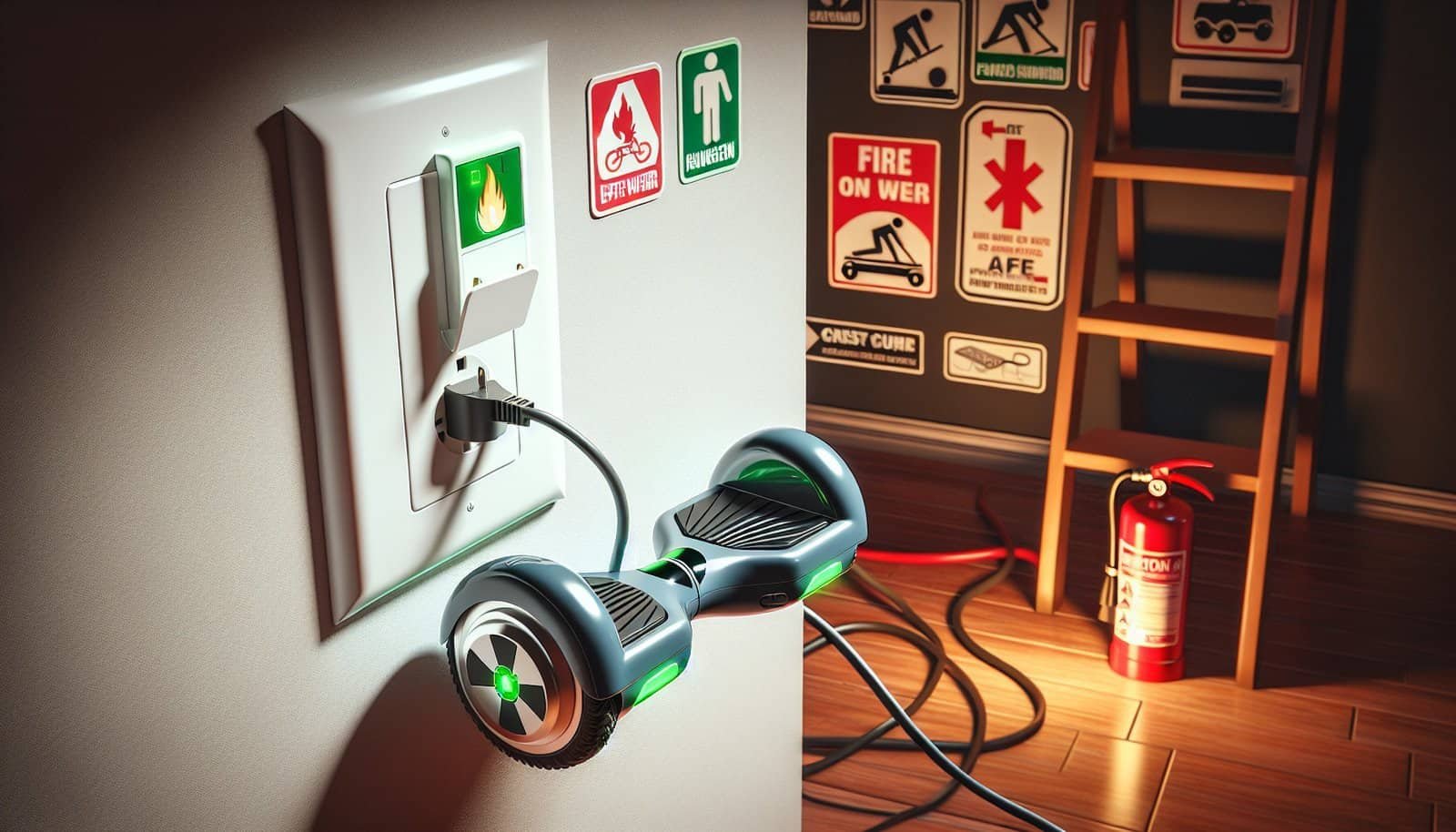If you’re the proud owner of a hoverboard, you may find yourself pondering the safest way to charge it while also wondering about the potential fire hazards that come with it. Fear not, because we’ve got you covered! In this article, we will explore the best practices for charging your hoverboard safely, as well as address any concerns you may have about potential fire risks. So, let’s dive in and ensure that your hoverboarding adventures are not only thrilling but also hazard-free!
Charging a Hoverboard Safely
Understanding the Hoverboard Battery
Before we dive into the details of charging a hoverboard safely, it’s important to have a basic understanding of the hoverboard battery. Most hoverboards use lithium-ion batteries, which are known for their energy density and rechargeable capabilities. These batteries can store a large amount of energy, but they also require careful handling to ensure safety.
Choosing the Right Charger
Choosing the right charger for your hoverboard is crucial to ensure safe and efficient charging. Using an incompatible or low-quality charger can lead to battery damage or even fires. It is recommended to use the charger provided by the manufacturer as they are designed specifically for your hoverboard model. If you need a replacement charger, make sure to purchase one from a reputable source that is compatible with your hoverboard.
Preparing the Charging Area
Creating a safe charging environment is essential to minimize the risk of fire hazards. Before plugging in your hoverboard, ensure that the charging area is clear of any flammable materials. It is also important to choose a flat and stable surface to prevent accidental tipping during the charging process. Additionally, keeping the charging area well-ventilated can help dissipate any heat generated during charging.
Plugging in the Charger Correctly
When plugging in the charger, make sure to insert it firmly into both the hoverboard’s charging port and the power outlet. Loose connections can result in an unstable charging process or even damage to the charging port. It’s always a good practice to double-check the connections to ensure they are secure before leaving your hoverboard to charge.
Monitoring the Charging Process
While your hoverboard is charging, it is important to keep an eye on the charging process. Most hoverboards have indicator lights that show the charging status. These lights typically change color or go off when the battery is fully charged. This monitoring ensures that you can promptly disconnect the charger once the charging is complete, preventing overcharging and potential battery damage.
Avoiding Overcharging
Overcharging can be detrimental to the battery’s health and increase the risk of fire hazards. To prevent overcharging, it is advisable not to leave your hoverboard plugged in for an extended period of time after it has reached full charge. Disconnecting the charger as soon as the battery is fully charged is crucial to maintaining the battery’s longevity and ensuring safety.
Disconnecting the Charger Safely
When the battery is fully charged or when you need to stop charging, make sure to disconnect the charger safely. Do not yank the charger out forcefully, as this could damage the charging port or the charger itself. Instead, gently unplug the charger, holding onto the plug instead of pulling on the cable. This simple precaution can help prevent any accidental damage and maintain the integrity of the charging system.
Fire Hazards Associated with Hoverboard Charging
Hoverboard charging, if not done correctly, can pose significant fire hazards. It is important to be aware of these potential risks and take necessary precautions to mitigate them.
Battery Defects and Quality
One of the most significant fire hazards associated with hoverboards is a defective or low-quality battery. Poorly manufactured batteries can be more prone to overheating, catching fire, or even exploding. Therefore, it is crucial to ensure that your hoverboard uses a high-quality battery from a reputable manufacturer, as this can significantly reduce the risk of fire hazards.
Using Non-Standard Chargers
Using non-standard chargers, such as chargers from different electronic devices, can be extremely dangerous. These chargers may not have the same voltage or current specifications required for your hoverboard’s battery. Using a charger that does not meet the manufacturer’s specifications can result in overcharging, battery damage, and ultimately, increase the chances of a fire.
Leaving Hoverboards Unattended While Charging
Leaving your hoverboard unattended while it is charging is a potential fire hazard that should be avoided at all costs. If a malfunction or overheating occurs in the battery or charger, immediate action is required to prevent a fire from spreading. By being present and attentive during the charging process, you can quickly address any issues and prevent a potential disaster.
Overcharging the Battery
Overcharging the battery is not only detrimental to its lifespan but also increases the risk of fire hazards. It is important to unplug the charger as soon as your hoverboard’s battery reaches full charge. Overcharging can cause excessive heat buildup within the battery, which can lead to thermal runaway and potentially result in a fire.
Charging Near Inflammable Materials
Charging your hoverboard near inflammable materials increases the risk of fire hazards. Avoid charging your hoverboard near items such as curtains, bedding, or other flammable substances. In case of a battery malfunction or fire, having these materials in close proximity can exacerbate the situation and make it difficult to control or extinguish the fire.
Ignoring Recall Notices
Manufacturers occasionally issue recall notices for hoverboards due to safety concerns, including fire hazards. Ignoring these notices can put you at greater risk. Stay informed about any recalls or safety bulletins related to your hoverboard model. If a recall is issued, follow the manufacturer’s instructions regarding the repair or replacement of the battery or any other components.
Faulty Wiring and Electrical Issues
Faulty wiring or electrical issues can contribute to fire hazards during hoverboard charging. Inspect the charger and the hoverboard for any signs of damage, such as frayed wires or loose connections. If you notice any issues, immediately stop using the charger and contact the manufacturer for further guidance. Regularly inspecting the charger and hoverboard can help identify potential electrical dangers and prevent accidents.

Identifying Safe Hoverboard Chargers
Choosing a safe and reliable charger for your hoverboard is critical to ensure both efficient charging and minimal fire hazards. Here are some key considerations when identifying a safe hoverboard charger.
Recommended Chargers by Manufacturer
One of the most reliable ways to ensure your hoverboard charger is safe is to use the charger provided by the manufacturer. Manufacturers design their chargers specifically for the associated hoverboard models, ensuring compatibility and compliance with safety standards. Whenever possible, it is recommended to use the charger recommended or provided by the manufacturer.
Certification Standards and Labels
Look for chargers that meet recognized safety standards and carry appropriate certifications such as UL, CE, or FCC. These certifications indicate that the charger has undergone rigorous testing to ensure it meets the necessary safety and performance standards. Though certifications alone cannot guarantee complete safety, they do provide a level of reassurance regarding the charger’s quality and safety.
Authenticating the Charger
When purchasing a replacement charger, make sure to verify its authenticity. Counterfeit chargers often do not meet safety standards and can pose significant risks. Check for manufacturer holograms, packaging details, or any other authenticity markers provided by the manufacturer. Purchasing chargers from authorized retailers or directly from the manufacturer can also help ensure you are getting a genuine product.
Using Chargers with Auto Shut-Off Feature
To further enhance safety during charging, consider using chargers with an auto shut-off feature. These chargers are designed to automatically stop charging once the battery reaches full capacity, preventing overcharging. This feature not only protects your battery but also reduces the risk of fire hazards associated with overcharging.
Creating a Safe Charging Environment
To minimize fire hazards during hoverboard charging, creating a safe charging environment is crucial. Here are some key steps to take to ensure a safe charging environment.
Choosing a Flat and Stable Surface
When selecting the location for charging your hoverboard, it is important to choose a flat and stable surface. A stable surface reduces the risk of accidental tipping during the charging process, ensuring that your hoverboard remains secure. Avoid charging on uneven or inclined surfaces to prevent any accidents or damage to your hoverboard.
Keeping the Charging Area Well-Ventilated
During charging, the hoverboard battery may generate some heat. It is essential to ensure that the charging area is well-ventilated to allow heat dissipation. Avoid charging in enclosed spaces or areas with poor ventilation, as this can increase the risk of overheating and potential fire hazards. Open windows or use fans to facilitate air circulation, especially in warm climates.
Avoiding Damp or Wet Environments
Water and electricity do not mix well, and charging your hoverboard in a damp or wet environment can be extremely dangerous. Never attempt to charge your hoverboard outdoors during rainy or snowy conditions. Moisture can damage the electrical components and increase the risk of short circuits or electrical shocks. Always charge your hoverboard in a dry and controlled environment.
Clearing Obstacles or Flammable Materials
Before plugging in your hoverboard to charge, clear the charging area of any obstacles or flammable materials. Ensure there is ample space around the hoverboard to prevent accidental contact with objects that could obstruct heat dissipation. Remove any flammable materials, such as papers, fabrics, or liquids, from the charging area to minimize fire hazards.
Ensuring Proper Power Source and Socket
To ensure the safety of your hoverboard and charger, it is important to plug them into a proper power source and socket. Use a grounded power outlet that can handle the electrical load required by your hoverboard charger. Avoid using extension cords or power strips, as they may not be designed to handle the power requirements of your charger, potentially leading to overheating or electrical hazards.
Using Surge Protectors
Using surge protectors can provide an extra layer of protection during hoverboard charging. Surge protectors are designed to safeguard against voltage fluctuations and power surges that can occur due to electrical issues or lightning strikes. By using a surge protector, you can help prevent damage to your charger and hoverboard in case of sudden power spikes or electrical disturbances.
Avoiding Extension Cords
It is recommended to avoid using extension cords for charging your hoverboard. Extension cords may not be rated for the high power draw of your hoverboard charger and can create a fire hazard. Instead, position your hoverboard and charger near a grounded power outlet. If the power outlet is far away, consider relocating or using a longer power cord that is specifically designed for your hoverboard charger.

Steps to Charge a Hoverboard
Now that we’ve covered the safety aspects of hoverboard charging, let’s walk through the step-by-step process of how to charge your hoverboard safely.
Checking the Battery Level
Before initiating the charging process, check the battery level on your hoverboard. Most hoverboards have a battery level indicator, which can be found on the device itself or through a mobile app. Make sure the battery level is not completely depleted; otherwise, the charger may take an extended time to charge the battery.
Finding the Charging Port
Locate the charging port on your hoverboard. Depending on the make and model, the charging port could be located on the side, bottom, or rear of the hoverboard. Refer to the user manual or manufacturer’s instructions if you are unsure about the exact location.
Connecting the Charger to Hoverboard
Take the charger provided by the manufacturer or a compatible replacement charger. Align the charger’s connector with the charging port on your hoverboard. Firmly insert the charger into the charging port until it fits securely. Ensure that the connection is tight and there is no wiggle or play in the charger.
Plugging the Charger into Power Outlet
Locate a suitable power outlet within close proximity to your hoverboard. Insert the charger’s plug into the power outlet, ensuring a snug fit. Check the charger’s indicator lights, which will typically turn on to indicate the charging process has started.
Verifying Charging Indicator Lights
Monitor the charger’s indicator lights to verify that the charging process is progressing normally. Different hoverboards use different color coding or blinking patterns to indicate the charging status. Consult your hoverboard’s user manual or manufacturer’s instructions to understand the specific indicator light pattern for your model.
Monitoring Charging Time
Keep an eye on the charging time. While the actual charging time will vary depending on the battery’s capacity and current charge level, hoverboards usually take a few hours to charge fully. Use this time to perform other tasks nearby, ensuring that you are still present and attentive to the charging process.
Removing the Charger After Full Charge
Once the charger’s indicator lights confirm that the battery is at full charge, promptly remove the charger from the power outlet. Unplug the charger from the hoverboard’s charging port, ensuring a gentle and controlled disconnection. Do not tug or pull on the charger cable, as it may damage the charging port or the charger itself.
Storing the Hoverboard and Charger Properly
After charging your hoverboard, it is important to store it and the charger properly. Disconnect and neatly coil the charger cable, taking care not to bend or kink it. Store the charger in a safe and dry location, away from potential sources of damage or moisture. Place the hoverboard in a cool and dry area, preferably away from direct sunlight, extreme temperatures, or humidity.
The Dangers of Overcharging
Overcharging your hoverboard battery can have serious consequences, both for the battery’s lifespan and your safety. It is crucial to understand the dangers associated with overcharging and take preventive measures.
Effects of Overcharging on Battery Life
Overcharging significantly reduces the lifespan of your hoverboard battery. Continuous exposure to excessive voltage and prolonged charging can cause the battery to deteriorate rapidly, ultimately leading to reduced capacity and a shorter overall battery life. To maximize the longevity of your hoverboard battery, it is important to avoid overcharging.
Risk of Battery Swelling or Explosion
Overcharging lithium-ion batteries can result in a phenomenon called “thermal runaway,” where a battery’s internal temperature increases uncontrollably. This can cause the battery to swell, leak dangerous chemicals, or even explode. To minimize the risk of such incidents, it is crucial to unplug the charger as soon as the battery reaches full charge.
Damage to Hoverboard Components
Overcharging not only affects the battery but can also damage other components of your hoverboard. The excessive heat generated during overcharging can put a strain on the electronic circuits, wiring, and connectors, potentially causing them to deteriorate, melt, or degrade over time. Protecting the longevity and operational safety of your hoverboard requires diligent monitoring of the charging process and preventing overcharging.
Increased Fire Hazard
Overcharging poses a significant fire hazard. The excessive heat generated during overcharging can increase the likelihood of battery failure, leading to thermal runaway, and potentially causing a fire. By avoiding overcharging, you can mitigate the risk of fire and ensure a safe charging experience.
Preventing Overcharging
To prevent overcharging, it is essential to closely monitor the charging process and disconnect the charger as soon as the battery reaches full charge. If your hoverboard has an auto shut-off feature, make sure it is enabled to automatically stop the charging process once the battery is fully charged. By taking these precautions, you can protect both the battery and your safety.

Preventing Fire Hazards during Charging
To ensure a safe charging experience, it is important to take additional precautions to prevent fire hazards. By following these guidelines, you can minimize the risk of fires during hoverboard charging.
Regularly Inspecting Hoverboard and Charger
Perform regular inspections of your hoverboard and charger to identify any signs of damage or wear. Look for frayed wires, loose connections, or any other issues that may compromise the electrical safety. If you notice any problems, discontinue use of the charger or hoverboard and contact the manufacturer for further guidance or assistance.
Proper Storage of Hoverboard and Charger
When not in use, store your hoverboard and charger in a safe and dry location. Keep them away from potential sources of damage, such as liquids, extreme temperatures, or direct sunlight. Storing them properly not only protects the equipment but also minimizes the risk of fire hazards.
Avoiding Charging Overnight
Charging your hoverboard overnight is not recommended, as it increases the risk of fire hazards. During extended periods of charging, especially when unattended, any issues with the charger or battery can go unnoticed and escalate into dangerous situations. Charge your hoverboard during the daytime or when you can be present and attentive throughout the charging process.
Keeping Fire Extinguishers Handy
As an additional safety measure, keep a fire extinguisher nearby in case of emergencies. In the event of a fire, a fire extinguisher can be a valuable tool to control and extinguish small fires before they escalate. Make sure you know how to use a fire extinguisher effectively and have it readily accessible in the charging area.
Having Smoke and Heat Detectors
Install smoke and heat detectors in the vicinity of your hoverboard charging area. Smoke detectors can quickly alert you to the presence of smoke, while heat detectors can detect excessive temperatures. These devices provide early warning signs of potential fire hazards, allowing you to take immediate action and prevent a fire from spreading.
Creating a Fire Escape Plan
In the unfortunate event of a fire, it is crucial to have a well-defined fire escape plan. Identify multiple exits and ensure they are easily accessible from the charging area. Communicate the escape plan to everyone in your household or those who frequently use the hoverboard. Practice the escape plan regularly to ensure everyone is familiar with the process.
Educating Users about Fire Safety
Promoting fire safety awareness is essential for preventing fire hazards during hoverboard charging. Educate all users, especially children and teenagers, about the potential risks and safety precautions associated with hoverboard charging. Emphasize the importance of following manufacturer guidelines, avoiding overcharging, and practicing proper charging procedures to ensure a safe charging experience.
Dealing with Battery Defects and Recalls
Battery defects pose significant safety risks and can lead to fires during hoverboard charging. It is crucial to be vigilant, inspect for any signs of battery defects, and take appropriate action to address these issues.
Signs of Battery Defects
Common signs of battery defects include unusual heating, swelling, leaking, or misshapen battery cells. If you notice any of these signs, it is important to take immediate action to prevent potential fire hazards. Do not attempt to use the hoverboard or charge it until the issue has been resolved.
Reporting and Contacting Manufacturer
If you suspect your hoverboard battery has a defect, or if you experience any safety issues during charging, contact the manufacturer immediately. Report the problem and provide them with any necessary information or documentation. The manufacturer can guide you on the next steps to address the issue, such as repair or replacement of the battery.
Recall Notices and Safety Bulletins
Pay attention to any recall notices or safety bulletins related to your hoverboard model. Manufacturers occasionally issue recalls to address safety concerns, including battery defects or fire hazards. Stay informed about any recalls and follow the manufacturer’s instructions regarding the battery replacement or repair process.
Following Recall Instructions
If your hoverboard model is subject to a recall, it is crucial to follow the manufacturer’s recall instructions. These instructions may include contacting the manufacturer directly or authorized service centers to facilitate the recall process. Always prioritize your safety and act promptly to address any known safety issues with your hoverboard.
Getting Battery Replaced or Repaired
If your hoverboard battery is defective or subject to a recall, the manufacturer will typically provide options for replacement or repair. Follow the manufacturer’s instructions regarding the battery replacement process, and only use genuine replacement batteries or authorized repair services. Using counterfeit or unauthorized batteries can be dangerous and increase the risk of fire hazards.
Disposing of Defective Batteries Properly
Properly dispose of defective or damaged batteries according to local regulations and guidelines. Do not attempt to repair or reuse batteries that have swelled, leaked, or sustained other damage. Improper disposal can harm the environment and pose risks to disposal workers. Contact local waste management authorities or recycling facilities for instructions on how to safely dispose of the defective batteries.

Regular Maintenance and Care
Regular maintenance and proper care of your hoverboard can help ensure its safe operation and extend its lifespan. By following these maintenance tips, you can reduce the risk of fire hazards during charging and overall usage.
Ensuring Clean Charging Port and Cables
Regularly clean the charging port and cables of your hoverboard to ensure proper connection and prevent debris or buildup that could interfere with charging. Use a clean and dry cloth or a gentle brush to remove any dirt or dust. Avoid using liquid cleaners, as they can damage the electrical components.
Inspecting Hoverboard for Damage
Frequently inspect your hoverboard for any signs of physical damage, such as cracks, dents, or loose parts. Damaged hoverboards can pose safety risks and increase the chances of electrical or fire hazards during charging. If you notice any damage, contact the manufacturer for guidance on repair or replacement options.
Replacing Worn-Out Parts
Over time, various components of your hoverboard may wear out due to regular usage. Replace worn-out parts, such as tires, footpads, or grips, as soon as you notice signs of deterioration. Worn-out parts can affect the overall performance and safety of your hoverboard, particularly during the charging process.
Proper Storage and Transportation
When storing or transporting your hoverboard, follow the manufacturer’s guidelines for proper handling. Avoid placing heavy objects on top of the hoverboard, as this can damage internal components. Use protective covers or bags specifically designed for hoverboard storage and transportation to prevent scratches, impacts, or exposure to moisture.
Regular Battery Conditioning
Battery conditioning involves fully discharging and then fully charging the battery periodically. This helps maintain the battery’s capacity and performance over time. Follow the manufacturer’s guidelines on the recommended frequency for battery conditioning to ensure optimal battery health and reduce the risk of fire hazards.
Avoiding Extreme Temperatures
Extreme temperatures, both hot and cold, can adversely affect the performance and safety of your hoverboard battery. Avoid charging your hoverboard in environments with extreme temperatures, as this can lead to overheating or reduced battery capacity. Store your hoverboard in a cool and dry environment to prevent exposure to direct sunlight or extreme temperature fluctuations.
Maintaining Optimal Tire Pressure
Proper tire pressure is important for optimal hoverboard performance and safety. Check the recommended tire pressure indicated by the manufacturer and ensure that the tires are properly inflated. Underinflated or overinflated tires can affect the hoverboard’s stability, control, and increase the risk of accidents or fire hazards during charging.
Avoiding Rough Surfaces
Hoverboards are designed for use on smooth and flat surfaces. Avoid riding your hoverboard on rough or uneven terrain, as this can damage the internal components or compromise its stability. Using your hoverboard on suitable surfaces minimizes the risk of damage, which can potentially lead to fire hazards during charging.
Conclusion
When it comes to charging your hoverboard safely, adhering to manufacturer guidelines and prioritizing safety is crucial. By understanding the hoverboard battery, choosing the right charger, and preparing a safe charging area, you can minimize the risk of fire hazards. Identifying safe hoverboard chargers, creating a safe charging environment, and following the recommended steps for charging are proactive steps towards ensuring safety. Additionally, being aware of the dangers of overcharging and taking preventive measures, such as regular maintenance and care, can further enhance safety during hoverboard charging. By remaining vigilant about fire hazards, regularly inspecting your hoverboard and charger, and promptly addressing any battery defects or recalls, you can enjoy the benefits of using your hoverboard while prioritizing safety. Remember, responsible usage, regular maintenance, and adherence to safety guidelines are the key to a safe and enjoyable hoverboard experience.


